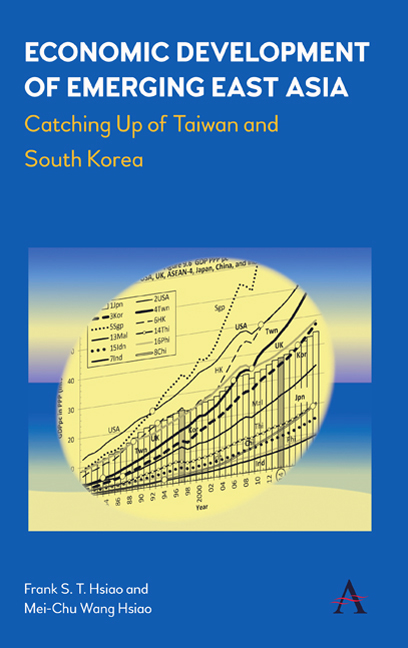Book contents
- Frontmatter
- Dedication
- Contents
- List of Figures
- List of Tables
- Sources of the Chapters
- Acknowledgments
- About the Authors
- Introduction
- Part I Studies of Emerging East Asian Economies: Taiwan and Korea
- Part II Catching Up and Convergence in East Asian Economic Growth
- 6 Miracle or Myth of Asian NICs’ Growth: The Irony of Numbers
- 7 “Miracle Growth” in the Twentieth Century: International Comparisons of East Asian Development
- 8 Catching Up and Convergence: On the Long-Run Growth in East Asia
- 9 Epilogue: From Emerging East Asia to an Asia-Centered World Economy
- Index
8 - Catching Up and Convergence: On the Long-Run Growth in East Asia
from Part II - Catching Up and Convergence in East Asian Economic Growth
Published online by Cambridge University Press: 10 January 2018
- Frontmatter
- Dedication
- Contents
- List of Figures
- List of Tables
- Sources of the Chapters
- Acknowledgments
- About the Authors
- Introduction
- Part I Studies of Emerging East Asian Economies: Taiwan and Korea
- Part II Catching Up and Convergence in East Asian Economic Growth
- 6 Miracle or Myth of Asian NICs’ Growth: The Irony of Numbers
- 7 “Miracle Growth” in the Twentieth Century: International Comparisons of East Asian Development
- 8 Catching Up and Convergence: On the Long-Run Growth in East Asia
- 9 Epilogue: From Emerging East Asia to an Asia-Centered World Economy
- Index
Summary
Abstract
Continuing from Chapters 5 and 6, this chapter attempts to combine the traditional learning model with the recent theory of economic growth using Maddison's long-run real GDP per capita data of the three fastest-growing countries in East Asia: Korea, Taiwan and Japan.
We first explain the game of catching up among nations in the World. We find that catching up and falling behind among countries are the rule rather than the exception. We then explain the learning coefficients of Taiwan and Korea with Japan and the United States through periods before and after World War II. The model of learning leads to a logistic model of economic growth of convergence between two countries. Using time-series data, the coefficients of a logistic model are estimated to confirm that the real GDP per capita of Taiwan and Korea is converging to that of Japan and that of the United States, respectively. Similarly, Japan's GDP per capita converges to that of the United States. The time required for finite convergence, other things being equal, for these countries is also estimated.
Introduction
One of the most important challenges for developing countries is to catch up with developed countries. It is a question of economic convergence, and is generally framed in terms of the convergence of the level of real GDP per capita. Historically, poorer countries develop faster than (and so catch up and converge with) richer countries, if the former are closely associated with the latter. Korea and Taiwan are good examples. Before World War II, both nations were colonies of Japan, which was the fastest-growing economy in the world during the period 1911– 40. Despite Japanese exploitation, both achieved high growth rates of real GDP per capita, and, by the end of the 1930s, their levels of real GDP per capita were higher than those of any other developing countries in Asia (Hsiao and Hsiao, 2003).
- Type
- Chapter
- Information
- Economic Development of Emerging East AsiaCatching Up of Taiwan and South Korea, pp. 225 - 246Publisher: Anthem PressPrint publication year: 2017

